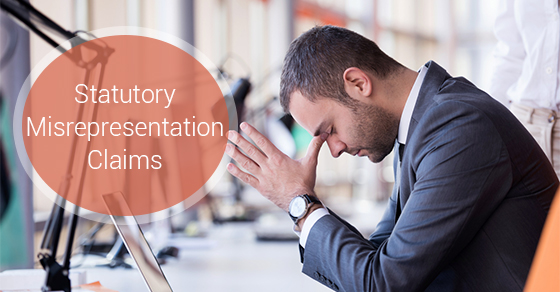Article Content
A claim under section 7 of the Arthur Wishart Act (Franchise Disclosure), 2000, seeks damages for either (a) misrepresentation by a franchisor of a material fact, or (b) failure by a franchisor to otherwise comply with disclosure obligations under the Act.
For ease of reference, subsection 7(1) of the Act provides as follows:
- 7.(1) If a franchisee suffers a loss because of a misrepresentation contained in the disclosure document or in a statement of a material change or as a result of the franchisor’s failure to comply in any way with section 5, the franchisee has a right of action for damages against,
- the franchisor;
- the franchisor’s agent;
- the franchisor’s broker, being a person other than the franchisor, franchisor’s associate, franchisor’s agent or franchisee, who grants, markets or otherwise offers to grant a franchise, or who arranges for the grant of a franchise;
- the franchisor’s associate; and
- every person who signed the disclosure document or statement of material change.
(For a discussion of a misrepresentation claim and the differences between a rescission and misrepresentation claims under the Act, you may wish to read the Law Works Franchise Blog article titled, A Comparison of Franchise Rescission and Misrepresentation Claims.)
Subsections 7(4) and (5) provide statutory defences for those liable under subsection 7(1). This article analyzes the elements of these statutory defences.
Preliminary Considerations
Defences Focused on Misrepresentation Claims
The defences contained in subsections 7(4) and (5) of the Act appear to apply only to a claim of misrepresentation, and not to a claim of failure to comply in any way with the disclosure obligations in the Act (which is the second component of subsection 7(1)).
The reason is that each of subsections 7(4) and (5) refers only ‘misrepresentation’ and does not refer to a failure to otherwise comply with the disclosure obligations, as the wording in subsection 7(1) does.
No Definition of ‘Person’
Both subsections 7(4) and (5) refer to a ‘person’ in providing him or her with defences. The natural assumption is that the reference to ‘person’ is to the following parties with liability as listed in subsection 7(1):
- the franchisor;
- the franchisor’s agent;
- the franchisor’s broker;
- the franchisor’s associate; and
- every person who signed the disclosure document or statement of material change.
What if any of these parties is not an individual, but a corporation?
This is most likely true in the case of a franchisor. And it is often true in the case of a franchisor’s associate, and perhaps even a franchisor’s broker.
The Act does not provide a definition of the term ‘person’. Does ‘person’ include a corporate franchisor, so that it can rely on the defences in subsections 7(4) and (5)? The Act is silent on this.
In order to avail itself of the defences in subsections 7(4) and (5), a franchisor would need to resort to statutory interpretation tools in order to include a corporate franchisor in the definition of ‘person’.
Burden of Proof
The general burden of proof applies to the proof of a cause of action under the Act.
With respect to the statutory defences in subsection 7(4) and (5), the onus of proof shifts – after misrepresentation is proved – to the person alleged to have made the misrepresentation to prove one or more of these statutory defences.
Defence based on Franchisee’s Knowledge (s. 7(4))
The focus of subsection 7(4) is on the knowledge of the franchisee (prospective franchisee at the time): his or her knowledge of the misrepresentation or material change.
Subsection 7(4) states as follows:
- 7(4) A person is not liable in an action under this section for misrepresentation if the person proves that the franchisee acquired the franchise with knowledge of the misrepresentation or of the material change, as the case may be.
Under this section, a person is not liable for misrepresentation if the franchisee bought the franchise with knowledge of the misrepresentation or material change.
Three Defences Based on Person’s Lack of Knowledge or consent Relating to the Disclosure Document (S. 7(5))
Subsection 7(5) contains three defences that relate to some problem with a disclosure document or statement of material change that was given to a franchisee (prospective franchisee at the time).
The three defences are focused on a person’s lack of knowledge or consent with respect to the delivery or content of the disclosure document or statement of material change.
For ease of reference, this article refers to the term ‘disclosure document or statement of material change’ in the context of the three defences in subsection 7(5) simply as ‘disclosure document’.
Without Consent (s. 7(5)(a))
The focus of subsection 7(5)(a) is on a person’s lack of knowledge of, or consent to, the fact that a disclosure document was given.
Subsection 7(5)(a) states as follows:
- 7(5) A person, other than a franchisor, is not liable in an action under this section for misrepresentation if the person proves,
- (a) that the disclosure document or statement of material change was given to the franchisee without the person’s knowledge or consent and that, on becoming aware of its having been given, the person promptly gave written notice to the franchisee that it was given without that person’s knowledge or consent.
The key components of this subsection are as follows:
- the disclosure document was given without the knowledge or consent of the person in question, and
- if the person becomes aware of this fact, he or she promptly gave notice to the franchisee that the disclosure document was given without that person’s knowledge or consent.
There is no timing reference, so the events giving rise to the defence may technically take place at any time.
Based on the wording of this subsection, a person may only become aware of the fact that a disclosure document was given without his or her knowledge or consent after the signing of a franchise agreement, and perhaps even after the expiration of the two year rescission period.
Would the defence still valid even in such circumstances? There is nothing in the wording of subsection 7(5)(a) that would indicate otherwise, i.e., a defence, at least technically speaking, will still be available in such circumstances.
Withdrawing Consent (s. 7(5)(b))
The focus of subsection 7(5)(b) is on a person’s knowledge of misrepresentation in the disclosure document, i.e., of the contents of the disclosure document (as opposed to the focus in subsection 7(5)(a), which is on the fact that the disclosure document was given).
Subsection 7(5)(b) states as follows:
- 7(5) A person, other than a franchisor, is not liable in an action under this section for misrepresentation if the person proves,
- (b) that, after the disclosure document or statement of material change was given to the franchisee and before the franchise was acquired by the franchisee, on becoming aware of any misrepresentation in the disclosure document or statement of material change, the person withdrew consent to it and gave written notice to the franchisee of the withdrawal and the reasons for it.
The key components of this subsection are as follows:
- the timing reference is before the franchise purchase was completed: after the disclosure document was given to the franchisee but before the franchise was acquired;
- unlike in subsection 7(5)(a), the issue here is not the person’s knowledge or consent, but rather the person ‘becoming aware of any misrepresentation in the disclosure document’, and
- once the person becomes aware of such a misrepresentation, he or she is required to do both of the following:
- withdraw his or her consent to the giving of the disclosure document to the franchisee, and
- give written notice to the franchisee of the withdrawal of his or her consent, together with the reasons for it.
Reliance on expert (s. 7(5)(c))
The focus of subsection 7(5)(c) is on a person’s reliance on information obtained from an expert.
Subsection 7(5)(c) states as follows:
- 7(5) A person, other than a franchisor, is not liable in an action under this section for misrepresentation if the person proves,
- (c) that, with respect to any part of the disclosure document or statement of material change purporting to be made on the authority of an expert or purporting to be a copy of or an extract from a report, opinion or statement of an expert, the person had no reasonable grounds to believe and did not believe that,
- there had been a misrepresentation,
- the part of the disclosure document or statement of material change did not fairly represent the report, opinion or statement of the expert, or
- the part of the disclosure document or statement of material change was not a fair copy of or extract from the report, opinion or statement of the expert.
The key components of this subsection are as follows:
- the disclosure document contains a part that is either made on the authority of an expert. or is a copy of an expert’s report, opinion or statement (for example, a financial statement);
- unlike in subsections 7(5)(a) or (b), the issue here is not the person’s knowledge or consent with respect to either the giving of the disclosure document or its contents, but rather on the person’s reliance on the expert with respect to the relevant part of the disclosure document;
- the person had no reasonable grounds to believe, and did not believe, that (a) there had been a misrepresentation, (b) the disclosure document did not fairly represent the relevant expert material, or (c) the relevant part of the disclosure document was not a fair copy or extract of the relevant expert material;
- Two different standards have to be proven here:
- that the person had no reasonable grounds to believe any of the above – this is called the “reasonable” or “objective” standard. It is not focused on the specific person’s knowledge or belief, but rather on what the reasonable person’s knowledge and belief would be in the circumstances; and
- that the person did not in fact believe any of the above – this is called a “subjective” standard. It is focused on the person’s actual knowledge and belief.
As this article intends to demonstrate, the legal elements of these defences are more complex than what initially meets the eye.
To date, no (or no significant) case law appears to have interpreted these defences in a substantive manner. I hope that, in time, the courts will have an opportunity to interpret and apply these defences.
This article is provided for information purposes only. Law Works’ Franchise Law Blog does not provide legal advice.
For more information about Law Works’ expertise and how we may be able to help you, please contact Ben Hanuka at https://www.lawworks.ca/book-a-consultation or by phone at (855) 978-5293.
Table of Contents
Ben Hanuka
JD, LLM, CS (Civ Lit), FCIArb, of the Ontario and BC Bars
Highlights:
- JD, LLM (Osgoode '96, '15), C.S. in Civ Lit (LSO), Fellow of CIArb, member of the Bars of Ontario ('98) and BC ('17)
- Principal of Law Works PC (Ontario)/LC (British Columbia)
- Acted as counsel in many leading franchise court decisions in Ontario over the past twenty-five years, including appellate decisions.
- Provided expert opinions in and outside Ontario
- Presented at and chaired numerous franchise and civil litigation CPD programs for over 20 years
- Chair of OBA Professional Development (2005-2006) - overseeing all PD programs
- Chair of Civil Litigation Section, OBA (2004-2005)
Notable Cases:
Mendoza v. Active Tire & Auto Inc., 2017 ONCA 471
1159607 Ontario v. Country Style Food Services, 2012 ONSC 881 (SCJ)
1518628 Ontario Inc. v. Tutor Time Learning Centres LLC (2006), 150 A.C.W.S. (3d) 93 (SCJ, Commercial List)
Bekah v. Three for One Pizza (2003), 67 O.R. (3d) 305, [2003] O.J. No. 4002 (SCJ)




